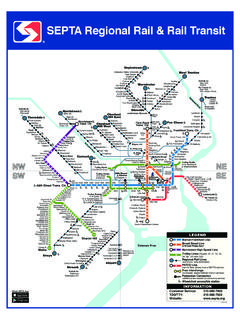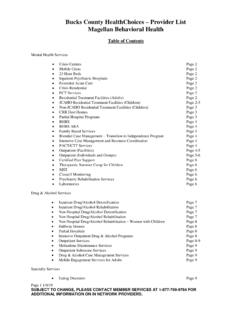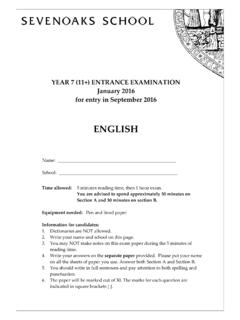Transcription of ANDEAN WEAVING ON A 4-SHAFT LOOM
1 ANDEAN WEAVING . ON A 4-SHAFT loom . WITH DIRECT TIE-UP. ELWYN KENN. SIMPLE WARP FLOATS ON A 4-SHAFT loom . 4 B L B. 3 B D B. 2 B L B. 1 B D B. Border Pattern Border Repeat for required number of threads for borders and pattern. WARPING. Wind single warps for the borders. For the pattern area two threads are wound together, 1 Dark and 1 Light. The pattern area is the number of squares on the graph - each with a dark and a light thread. Warp with a cross and tie to the back roller beam. For a 4-SHAFT loom thread shafts 1 and 3 with DARK threads and shafts 2 and 4 with LIGHT threads. The reed is not used. WEAVING . For this and all the following patterns the weft shuttle is wound with the same yarn and the same colour used for the outside edge warps of the borders. Weave several rows of dark and light horizontal bars using Shed 1 ( Dark) the Shed 2. (2,4 Light). Beat each row firmly. If the next row of the pattern has Dark floats, end with a Dark bar. If working Light floats then end with a Light bar.
2 TO BEGIN THE PATTERN. TO WORK A PATTERN WITH DARK FLOATS. Open Shed 1 ( Dark) and pass the weft through. Using a pick-up stick, pick up the Dark threads according to the pattern. Open Shed 2 (2,4 Light) and push the pick-up stick containing the picked up Dark threads back toward the heddles. Pass the weft through the new shed (Light threads and the picked up Dark threads). Repeat. TO WORK A PATTERN WITH LIGHT FLOATS. Open Shed 2 (2,4 Light) and pass the weft through. Pick up the Light threads according to the pattern. Open Shed 1 (1,3 Dark) and push the pick-up stick containing the picked up Light threads back toward the heddles. Pass the weft through the new shed (Dark threads and the picked up Light threads). Repeat. Elwyn Kenn 2012 1. SIMPLE WARP FLOATS ON A 4-SHAFT loom . WARPING. DARK FLOAT PATTERN. For the borders wind 4 single warps in Black, 4 in Red and then 4 in Black for each border. The graph for the pattern area is 26 squares. Wind together 12 Black and White, 2 Black and Red and then 12 Black and White warps.
3 Work following the directions on page 1. 26. Adapted from a pattern by Mary M Atwater Elwyn Kenn 2012 2. SIMPLE WARP FLOATS ON A 4-SHAFT loom . WARPING. LIGHT FLOAT PATTERN. For the borders wind 8 single warps in Navy for each border. The graph for the pattern area is 26 squares. Wind together 26 Navy and 26 White warps. Repeat the pattern graph. Work following the directions on page 1. 26. Elwyn Kenn 2012 3. SIMPLE WARP FLOATS ON A 4-SHAFT loom . WARPING. DARK AND LIGHT FLOAT PATTERN. For the borders wind 8 single warps in Navy for each border. The graph for the pattern area is 26 squares. Wind together 26 Navy and 26 White warps. Work following the directions on page 1 picking up either dark or light warps on every alternate row according to the pattern. Repeat 26.. Elwyn Kenn 2012 4. WARP FLOATS ON A 4-SHAFT loom . Shed 1 (DARK). 4. Shafts 1,3 - L to R. 3. Shed 2 (LIGHT). 2. Shafts 2,4 - R to L. 1. Border Thread as above using White and Border Mid Blue, Light Blue, Green and Navy WARPING.
4 For the border wind 4 single warps in Navy and 4 single warps in Green. The pattern area is the number of squares on the graph (22) - each with a white and a coloured thread. The pattern area has two warps wound together. Wind the following colours together with White. 4 warps Navy 3 warps Mid Blue. 3 warps Light Blue. 2 warps Green. all with White 3 warps Light Blue. 3 warps Mid Blue 4 warps Navy. Wind 4 single warps in Green and 4 single warps in Navy. Warp with a cross and tie to the back roller beam. Thread the heddles with these 60 threads. WEAVING . Open Shed 1 (Dark) and pass the weft from LEFT to RIGHT. To begin the pattern open Shed 2 (LIGHT). Pass the weft from RIGHT to LEFT. 1st Pattern row Using a pick-up stick select the pattern warps from Shed 2 (LIGHT). according to the pattern. Open Shed 1 (DARK) and push the pick-up stick containing the picked up pattern warps from Shed 2 back toward the heddles. Pass the weft through the new shed (Shed 1 and the picked up pattern warps from Shed 2) from LEFT to RIGHT.
5 2nd Pattern row Using a pick-up stick select the pattern warps from Shed 1 (DARK). according to the pattern. Open Shed 2 (LIGHT) and push the pick-up stick containing the picked up pattern warps from Shed 1 back toward the heddles. Pass the weft through the new shed (Shed 2 and the picked up pattern warps from Shed 1) from RIGHT to LEFT. Continue to weave according to the graph, working 1st and 2nd pattern rows as re- quired. 5. Elwyn Kenn 2012. WARP FLOATS ON A 4-SHAFT loom . 30. 30. Elwyn Kenn 2012 6. WARP FLOATS ON A 4-SHAFT loom . 4 Shed 1 (DARK). 3 Shafts 1,3 - L to R. 2 Shed 2 (LIGHT). 1 Shafts 2,4 - R to L. Border Thread as above using White and Navy, Border Mid Blue, Blue, Green and Light Green WARPING. For the borders wind 6 single warps in Navy and 2 single warps in Green. The pattern area is the number of squares on the graph (42) - each with a white and a coloured thread. The pattern area has two warps wound together. Wind the following colours together with White.
6 4 warps Navy 6 warps Mid Blue 6 warps Blue 4 warps Green all with White 2 warps Light Green 4 warps Green 6 warps Mid Blue 6 warps Navy Warp with a cross and tie to the back roller beam. Thread the heddles with these threads. Work following the directions on page 5. Elwyn Kenn 2012 7. WARP FLOATS ON A 4-SHAFT loom . 58. Elwyn Kenn 2012 8. SUPPLEMENTARY WARP ON A 4-SHAFT loom . 3. 2. 1. Border Pattern Border WARPING. For the borders wind 4 single warps in White, 4 in Red then 1 White and 1 Black warp 4 times (8 threads) finishing the borders with 4 Red warps. The pattern area is the number of squares on the graph (38), each with 2 ground warps and one suplementary warp. The pattern area has 3 warps wound together. The ground weave uses shaft 1 and shaft 2 alternately. shaft 3 is used for the supplemen- tary pattern warps. TO WEAVE A LIGHT BACKGROUND WITH A DARK PATTERN. Light Ground Begin the WEAVING on the left-hand side of the braid. Open shaft 1, pass the weft from left to right, then open shaft 2 and pass the weft from right to left.
7 Dark Pattern Bands Single Row. shaft 3 raises the Dark warps. Beat these warps, then raise shaft 1 (1 and 3 together). Pass the weft through the shed. Continue using shaft 2 for the next light row. shaft 2 is used with shaft 3 when the dark band is to be worked from the right. Double Row. Open shaft 3, beat, then open shaft 1 (1 and 3 together). Pass the weft, then open shaft 2. ( shaft 2 and 3 together) and pass the weft. If the band is to be worked from the right then first open shaft 2 and then shaft 1. TO BEGIN THE PATTERN. 1st Pattern row Open shaft 3 raising the dark pattern warps. Using a pick-up stick pick up the warps required for the pattern, then close shaft 3 and open shaft 1. Push the pick- up stick back toward the heddles. Pass the weft through the ground warp and the picked up pattern warps from left to right. Remove the stick and beat well. 2nd Pattern row Open shaft 3 and pick up the pattern warps for the next row. Close shaft 3. Open shaft 2 and push the stick back toward the heddles.
8 Pass the weft through the ground warp and the picked up pattern warps from right to left. Remove the stick and beat well. shaft 1 and shaft 2 are worked alternately for the ground weave. The pattern is worked using the 1st or 2nd pattern row as required for the ground weave. Elwyn Kenn 2012 9. SUPPLEMENTARY WARP ON A 4-SHAFT loom . 38. Adapted from a pattern by Mary M Atwater Elwyn Kenn 2012 10. 2 COLOUR SUPPLEMENTARY WARP. 4. 3. 2. 1. Border Pattern Border WARPING. For the borders wind 4 single warps in White and 4 single warps in Tan. The pattern area is the number of squares on the graph (20), each with 2 ground warps and 2 supplementary warps. The pattern area has 4 warps wound together. The ground weave uses shaft 1 and shaft 2 alternately. shaft 3 is used for the first supple- mentary warp and shaft 4 is used for the second supplementary warp. WEAVING THE GROUND. Begin the WEAVING on the left-hand side of the braid. Open shaft 1, pass the weft from left to right, then open shaft 2 and pass the weft from right to left.
9 TO BEGIN THE PATTERN USING 2 SUPPLEMENTARY COLOURS. Open the shaft for the first colour ( shaft 3). Using a pick-up stick pick up the the first coloured warps required for the pattern. Open the shaft with the 2nd colour ( shaft 4) and pick up the second coloured warps required with a second pick-up stick. Close the sheds and open the next ground row (either shaft 1 or shaft 2). Push the pick- up sticks back toward the heddles. Pass the weft through the ground warps and the picked up pattern warps. Remove the sticks and beat well. Repeat. Elwyn Kenn 2012 11. 2 COLOUR SUPPLEMENTARY WARP. Repeat 20. Adapted from a pattern by Cason and Cahlander (The Art of Bolivian Highland WEAVING 1976). Elwyn Kenn 2012 12. WARP SUBSTITUTION ON A 4-SHAFT loom . Shed 1 - 1,3 Left to Right 4. 3 Shed 2 - 2,4 Right to Left 2. 1 Repeat threading the heddles for borders and the pattern as required Border Pattern Border WARPING. When following the chart for warp substitution the number of pattern squares on the graph is multiplied by 4.
10 This pattern has 24 squares. For the border wind 4 single warps in Black, 4 in Red then 4 in Black. For the pattern area wind together 20 double warps in Black and White, 8 double warps in Red and 20 double warps in Black and White. For the second border wind 4 Black, 4 Red and 4 Black single warps. Warp with a cross and tie to the back roller beam. Thread the heddles with these threads. You can choose to have either a Dark or a Light background when working from the pattern chart. The pattern is charted using the diamond grid. WEAVING . TO WORK DARK OR LIGHT ROWS BETWEEN PATTERNS. Begin from the left side of the band. 1st row Open Shed 1,3. Place a stick under the border warps. Open shaft 2 (DARK) or shaft 1 (LIGHT) and place a stick under the pattern warps (not the border warps). Open Shed 1,3 again and push both sticks back toward the heddles, lift the sticks and pass the weft from LEFT to RIGHT through the new shed and beat. 2nd row Open Shed 2,4. Place a stick under the border warps.






